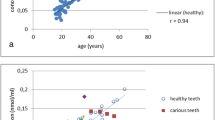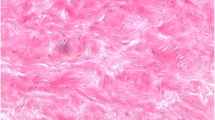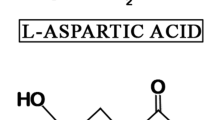Abstract
Age estimation based on aspartic acid racemization (AAR) in dentine is one of the most precise methods in adult age. Caries induces protein degradation and may have an impact on the kinetics of AAR in dentine. We systematically examined standardized prepared dentine samples from caries-affected teeth to clarify the question, if caries-affected teeth should not be used for age estimation based on AAR at all, or if the analysis of dentine samples from such teeth may be useful after removal of the caries-affected tissue according to clinical standards. Our results suggest that caries may lead to an extensive protein degradation even in macroscopically healthy-appearing dentine samples from caries-affected teeth and may significantly affect the precision of age estimation. To ensure the quality of age estimation based on AAR in forensic practice, we recommend using dentine samples from healthy teeth. If only caries-affected teeth are available, dentine samples from at least two teeth from the same individual should be analyzed as it seems unlikely that caries-induced protein degradation occurred with identical kinetics in two different teeth. In any case, results of the analysis of caries-affected teeth must be interpreted with caution.




Similar content being viewed by others
References
Meissner C, Ritz-Timme S (2010) Molecular pathology and age estimation. Forensic Sci Int 203:34–43
Ritz-Timme S, Cattaneo C, Collins MJ, Waite ER, Schütz HW, Kaatsch HJ, Borrman HIM (2000) Age estimation: the state of the art in relation to the specific demands of forensic practise. Int J Legal Med 113:129–136
Ohtani S (1995) Estimation of age from the teeth of unidentified corpses using the amino acid racemization with reference to actual cases. Am J Forensic Med Pathol 16:238–242
Collins MJ, Waite ER, van Duin ACT (1999) Predicting protein decomposition: the case of aspartic-acid racemization kinetics. Phil Trans R Soc Lond B 354:51–64
Robinson NE, Robinson AB (2004) Molecular clocks. Deamidation of asparaginyl and glutaminyl residues in peptides and proteins. Althouse Press, Cave Junction
Stephenson RC, Clarke S (1989) Succinimide formation from aspartyl and asparaginyl peptides as a model for the spontaneous degradation of proteins. J Biol Chem 11:6164–6170
Truscott RJW (2011) Macromolecular deterioration as the ultimate constraint on human lifespan. Ageing Res Rev 10:397–403
Truscott RJW, Schey KL, Friedrich MG (2016) Old proteins in man: a field in its infancy. Trends Biochem Sci 41(8):654–664
Helfman PM, Bada JL (1976) Aspartic acid racemization in dentine as a measure of ageing. Nature 262:279–281
Ritz S, Schütz HW, Peper C (1993) Postmortem estimation of age at death based on aspartic acid racemization in dentin: its applicability for root dentin. Int J Legal Med 105:289–293
Helfman PM, Bada JL (1975) Aspartic acid racemization in tooth enamel from living humans. Proc Nat Acad Sci USA 72:2891–2894
Griffin RC, Moody H, Penkman KEH, Collins MJ (2008) The application of amino acid racemization in the acid soluble fraction of enamel to the estimation of the age of human teeth. For Sci Int 175(1):11–16
Tiemeyer H (2002) Razemisierung von Asparaginsäure in Schmelzproteinen: Forensische Nutzbarkeit zur biochemischen Lebensaltersschatzung und grundlagenwissenschaftliche Aspekte. Dissertation, University of Kiel
Ohtani S, Sugimoto H, Sugeno H, Yamamoto S, Yamamoto K (1995) Racemization of asparagin acid in human cementum with age. Archs oral Biol 40(2):91–94
Barber JR, Clarke S (1983) Membrane protein carboxyl methylation increases with human erythrocyte age. J Biol Chem 258:1189–1196
Brunauer L, Clarke S (1986) Age-dependent accumulation of protein residues which can be Hydolized to D-aspartic acid in human erythrocytes. J Biol Chem 261:12538–12543
Lowenson J, Clarke S (1988) Does the chemical instability of aspartyl and asparaginyl residues in proteins contribute to erythrocyte aging? Blood Cells 14:103–117
Pfeiffer H, Mörnstad H, Teivens A (1995) Estimation of chronologic age using the aspartic acid racemization method. II. On human cortical bone. Int J Legal Med 108:24–26
Ritz S, Turzynski A, Schütz HW (1994) Estimation of age at death based on aspartic acid racemization in noncollagenous bone proteins. Forensic Sci Int 69:149–159
Maroudas A, Stockwell RA, Nachemson A, Urban J (1975) Factors involved in nutrition of the human lumbar intervertebral disc: cellularity and diffusion of glucose in vitro. J Anat 120:113–130
Ritz S, Schütz HW (1993) Aspartic acid racemization in intervertebral discs as an aid to postmortem estimation of age at death. J Forensic Sci 38:633–640
Garner WH, Spector A (1978) Racemization in human lens: evidence of rapid insolubilization of specific polypeptides in cataract formation. Proc Natl Acad Sci U S A 75:3618–3620
Helfman PM, Bada JL (1977) Aspartic acid racemization in the human lens during ageing and in cataract formation. Nature 268:71–73
Masters PM, Bada JL, Zigler JS Jr (1978) Aspartic acid racemization in heavy molecular weight crystallins and water-insoluble protein from normal human lenses and cataracts. Proc Natl Acad Sci U S A 75:1204–1208
Klumb K, Matzenauer C, Reckert A, Lehmann K, Ritz-Timme S (2016) Age estimation based on aspartic acid racemization in human sclera. Int J Legal Med 130:207–211
Matzenauer C, Reckert A, Ritz-Timme S (2014) Estimation of age at death based on aspartic acid racemization in elastic cartilage of the epiglottis. Int J Legal Med 128:995–1000
Pfeiffer H, Mörnstad H, Teivens A (1995) Estimation of chronologic age using the aspartic acid racemization method. I. On human rib cartilage. Int J Legal Med 108:19–23
Ritz S, Turzynski A, Schütz HW, Hollmann A, Rochholz G (1996) Identification of osteocalcin as a permanent aging constituent of the bone matrix: basis for an accurate age at death determination. For Sci Int 770:13–26
Shapiro SD, Endicott SK, Province MA, Pierce JA, Campbell EJ (1991) Marked longevity of human lung parenchymal elastic fibers deduced from prevalence of D-aspartate and nuclear weapons-related radiocarbon. J Clin Invest 87:1828–1834
Powell JT, Vine N, Crossman M (1992) On the accumulation of D-aspartate in elastin and other proteins of the ageing aorta. Atherosclerosis 97:201–208
Ritz-Timme S, Laumeier I, Collins MJ (2003) Aspartic acid racemization: evidence for marked longevity of elastin in human skin. Brit J Derm 149:951–959
Ritz-Timme S, Laumeier I, Collins MJ (2003) Age estimation on aspartic acid racemization in elastin from the yellow ligaments. Int J Legal Med 117:96–101
Ohtani S, Yamamoto T (2005) Strategy for the estimation of chronological age using the aspartic acid racemization method with special reference to coefficient of correlation between D/L ratios and ages. J Forensic Sci 50:1–7
Ritz-Timme S, Rochholz G, Schütz HW, Collins MJ, Waite ER, Cattaneo C, Kaatsch HJ (2000) Quality assurance in age estimation based on aspartic acid racemisation. Int J Legal Med 114:83–86
Ritz-Timme S (1999) Lebensaltersbestimmung aufgrund des Razemisierungs-grades von Asparaginsäure. Grundlagen, Methodik, Möglichkeiten, Grenzen, Anwendungsbereiche. In: Berg S, Brinkmann B (eds) Arbeitsmethoden der medizinischen und naturwissenschaftlichen Kriminalistik, 23rd edn. Lübeck, Schmidt-Römhild, pp 1–84
Ohtani S (1995) Estimation of age from dentin by using the racemization reaction of aspartic acid. Am J Forensic Med Pathol 16:158–161
Ohtani S, Yamamoto K (1991) Age estimation using the racemization of amino acid in human dentin. J Forensic Sci 36:792–800
Author information
Authors and Affiliations
Corresponding author
Ethics declarations
Ethical approval
All procedures performed in studies involving human participants were in accordance with the ethical standards of the institutional and/or national research committee and with the 1964 Helsinki declaration and its later amendments or comparable ethical standards.
Rights and permissions
About this article
Cite this article
Sirin, N., Matzenauer, C., Reckert, A. et al. Age estimation based on aspartic acid racemization in dentine: what about caries-affected teeth?. Int J Legal Med 132, 623–628 (2018). https://doi.org/10.1007/s00414-017-1667-6
Received:
Accepted:
Published:
Issue Date:
DOI: https://doi.org/10.1007/s00414-017-1667-6




